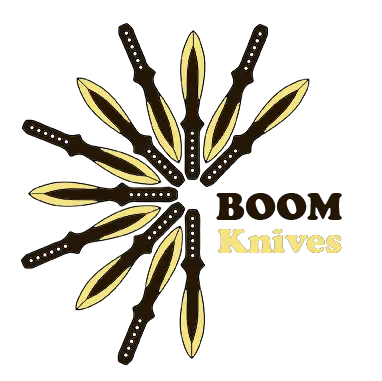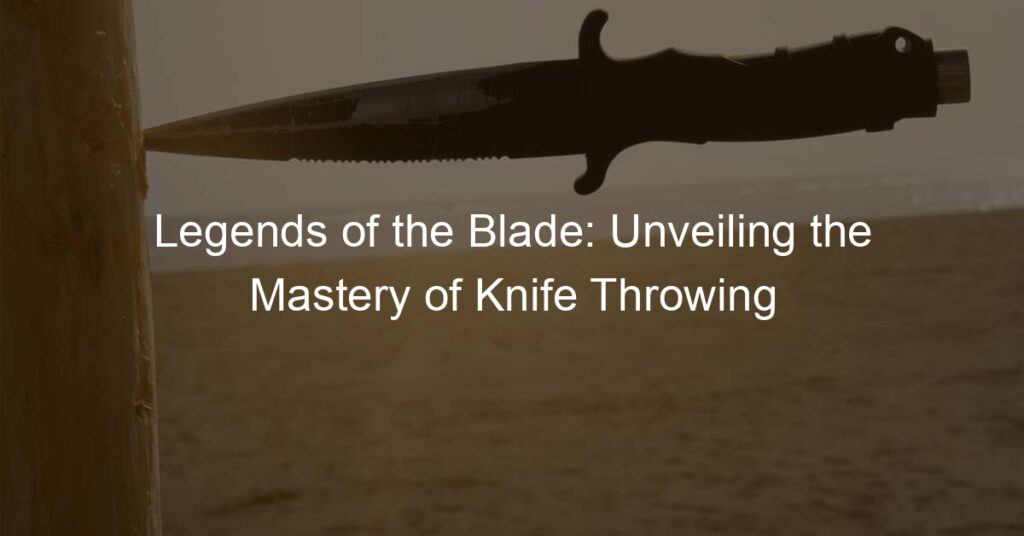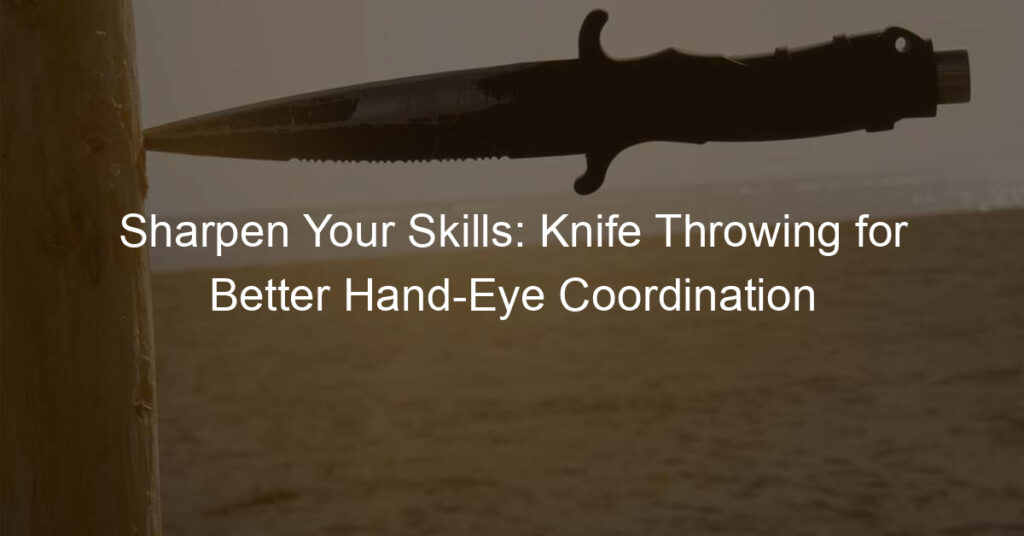Introduction to Knife Throwing
This introductory guide will take you through the origins of knife throwing, help you understand the art, and highlight the importance of honing this unique skill.
-
- Origins of Knife Throwing
The art of knife throwing has a rich history that dates back to prehistoric times. Early humans used thrown knives as hunting tools and weapons. Over time, this practical skill evolved into a form of entertainment and sport. The first recorded knife throwing competitions took place in the Middle Ages, making it a centuries-old tradition.
-
- Understanding the Art of Knife Throwing
It’s a discipline that requires concentration, coordination, and a deep understanding of physics. The thrower must calculate the rotation of the knife and the distance to the target to ensure a successful hit. It’s a thrilling spectacle that combines athleticism with mental acuity.
-
- Importance of Knife Throwing Skills
Aside from being an exciting hobby or competitive sport, it can also improve your hand-eye coordination, focus, and physical fitness. Moreover, it’s a unique skill that can boost your confidence and provide a sense of accomplishment.
Knife Throwing Techniques
-
-
- Handle Grip: This is the most common grip for beginners. Hold the knife by the handle, ensuring your fingers are not in the path of the blade.
- Blade Grip: This technique involves holding the knife by the blade. It requires more caution, but it can provide more control over the throw.
- Overhand Throw: This is the most common throw, similar to throwing a baseball. The knife is thrown over the shoulder, providing a direct and powerful throw.
-
-
- Advanced Knife Throwing Techniques
-
-
- Multiple Knife Throwing: This technique involves throwing multiple knives in quick succession. It requires a high level of skill and precision.
- Trick Throws: These are throws that involve spins, flips, or other tricks. They are often used in competitions or performances.
-
-
-
- Focus on the Target: Keep your eyes on the target at all times. This will help you aim more accurately.
- Consistent Grip and Throw: Consistency is key. The more consistent your grip and throw, the more accurate you will be.
- Practice: The more you practice, the more accurate you will become. Make sure to practice regularly and in different conditions to improve your skills.
-
Knife Throwing Mastery
Steps to Master Knife Throwing
- Step 1: Understanding the BasicsThis involves learning about the different types of throwing knives, their weight, balance, and how they are held. You also need to understand the correct stance and throwing technique. A good starting point is to read books on knife throwing or watch instructional videos.
- Step 2: Practicing RegularlySet aside time each day to practice your throws. Start with close targets and gradually increase the distance as your accuracy improves. It’s not about how hard you throw, but how accurately you throw. Keep track of your progress and make adjustments as necessary.
- Step 3: Learning from the ExpertsAttend knife throwing workshops, join a local club, or follow expert throwers on social media. Watch their technique closely and don’t be afraid to ask questions.
Benefits of Knife Throwing Mastery
-
- Improved Focus and Concentration
You need to pay attention to your grip, your stance, and your target. This intense focus can translate into other areas of your life, helping you to improve your overall concentration and attention to detail. It’s a skill that can be beneficial in various situations, from studying for an exam to completing a complex work task.
-
- Enhanced Hand-Eye Coordination
The act of aiming and throwing the knife at the target requires precise coordination between your hands and eyes. Over time, this can enhance your reflexes and overall motor skills, which can be beneficial in many other sports and daily activities.
-
- Boosted Confidence and Self-Esteem
There’s a certain sense of accomplishment that comes with hitting your target. As you improve and start to hit your target more consistently, you’ll likely notice a boost in your confidence and self-esteem. This can have a positive impact on other areas of your life, from your personal relationships to your professional endeavors.
Legendary Knife Throwers
Stories of Knife Throwers
-
The Tale of the First Knife Thrower
The first recorded knife thrower was a man named Carnado, who lived in the 15th century. Carnado was a soldier who used his knife-throwing skills in battle. His legendary precision and speed made him a feared opponent. Carnado’s story is a testament to the origins of knife throwing as a martial art.
-
Stories of Famous Knife Throwers
Throughout history, many knife throwers have gained fame for their exceptional skills. One such individual is Elizabeth Green, a 19th-century performer known for her knife-throwing act. She was one of the first women to gain prominence in the field, breaking gender barriers and inspiring many others.
-
Modern Day Knife Throwing Legends
In the modern era, knife throwing continues to thrive with several individuals making their mark. One such legend is David Adamovich, also known as ‘The Great Throwdini’. He holds multiple world records and is renowned for his speed throwing. His dedication to the sport has helped popularize knife throwing in the 21st century.
Knife Throwing History
- Knife Throwing in Ancient TimesOur ancestors used thrown knives as hunting tools. In ancient Egypt, knife throwing was a popular sport, with competitors vying for the title of the most accurate thrower. The Greeks and Romans also practiced knife throwing, both for sport and in warfare. The Roman soldiers were particularly known for their skill in hurling the ‘pilum’, a type of throwing knife.
- Evolution of Knife ThrowingIn the Middle Ages, it was a popular pastime at fairs and festivals. By the 19th century, knife throwing had become a staple act in circuses and vaudeville shows, with performers astonishing audiences with their precision and daring. The knives used also evolved, becoming more specialized and balanced for throwing.
- Knife Throwing in the Modern EraModern throwers use a variety of techniques, and the knives have become even more specialized. Competitions are held regularly, and the sport has a growing fan base. Despite its ancient roots, knife throwing continues to evolve and captivate audiences with its blend of skill, precision, and danger.
Famous Knife Throwers
-
Profile of a Knife Throwing Champion
Meet Jack Dagger, a world-renowned knife thrower and champion. Born as Todd Abrams, he adopted the stage name Jack Dagger. Known for his accuracy and speed, Jack has won numerous competitions worldwide. He is also a member of the International Knife Throwers Hall of Fame.
Jack began his knife-throwing journey at a young age, inspired by the cowboy movies he watched as a child. He practiced tirelessly, honing his skills and perfecting his technique. His dedication and passion for the sport have made him a respected figure in the knife-throwing community.
-
Interview with a Knife Throwing Expert
The Great Throwdini. He holds the world record for the most knife throws in a minute. Dr. Adamovich shared some of his experiences and tips for aspiring knife throwers.
“Knife throwing is not just about strength, it’s about precision, timing, and focus. It’s a mental game as much as it is a physical one,” he said. “For those starting out, my advice is to be patient. It takes time to develop the skills and accuracy required for this sport.”
-
Life of a Knife Throwing Record Holder
Revolva a knife throwing record holder. Born in the UK, Revolva discovered her passion for knife throwing at a young age. She holds the record for the most consecutive knife target strikes without a miss.
Revolva’s journey wasn’t easy. She faced numerous challenges, including overcoming the fear of throwing sharp objects. However, her determination and love for the sport helped her overcome these obstacles and achieve her dream.
Knife Throwing Champions
Knife Throwing Records
-
- World Record for Longest Knife Throw
David Adamovich. He made a throw that covered an incredible distance of 63 feet and 6 inches. The world record for the longest knife throw is held by David Adamovich, also known as ‘The Great Throwdini’. This record was set in 2008 and remains unbeaten to this day.
-
- Record for Most Accurate Knife Throw
Rev Dr. Jack Dagger. He is known for his exceptional accuracy and precision. The record for the most accurate knife throw is held by Rev Dr. Jack Dagger. In 2009, he threw a knife at a target 15 feet away and hit the bullseye 100 times in a row without a single miss.
-
- Fastest Knife Throwing Record
He managed to throw 102 knives around a human target in just one minute. This record was set in 2007 and is a testament to his speed and accuracy. The fastest knife throwing record is also held by David Adamovich.
Conclusion: The Future of Knife Throwing
-
- The Evolution of Knife Throwing Techniques
Just as the techniques of knife throwing have evolved over the centuries, they will continue to do so. New materials and technologies will undoubtedly influence the design and construction of throwing knives. We can expect to see more sophisticated training methods and equipment, as well as new throwing techniques that will push the boundaries of what is currently possible. Wikipedia is a great resource for keeping up with these developments.
-
- Future Prospects for Knife Throwing Champions
As the sport of knife throwing grows in popularity, so too will the opportunities for those who excel in it. Future champions can look forward to larger audiences, bigger competitions, and more lucrative prizes. They may even find themselves becoming household names, much like top athletes in other sports. The future is bright for those who dedicate themselves to mastering this unique skill.
-
- How Knife Throwing Expertise Will Change the World
While it may seem like a bold claim, the expertise of knife throwing can indeed have a positive impact on the world. This sport teaches discipline, focus, and precision, skills that are valuable in many aspects of life. As more people take up knife throwing, we may see these benefits ripple out into the wider world. Furthermore, the growth of this sport can contribute to cultural exchange and understanding as people from different backgrounds come together to share their love of knife throwing.







